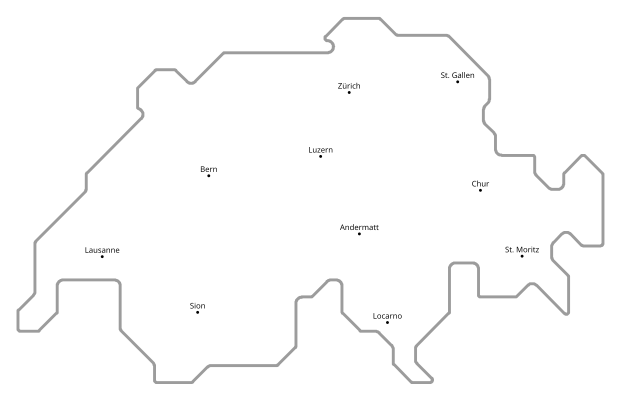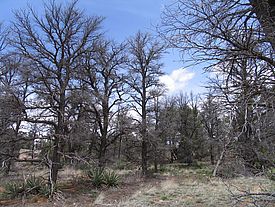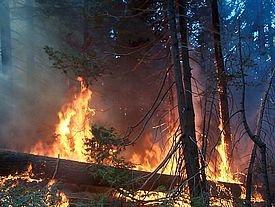24.02.2016 | News
Forests all over the United States are feeling the heat from increasing drought and climate change. This was outlined in a recent study published in Global Change Biology by a new Duke University-led investigation with scientists from 14 research institutions including Niklaus E. Zimmermann of the Swiss Federal Research Institute WSL. While the effects have been most pronounced in the Western part of the country, the new study finds virtually all U.S. forests are now experiencing some degree of change and are vulnerable to future declines.
"Over the last two decades, warming temperatures and variable precipitation have increased the severity of forest droughts across much of the continental United States," said James S. Clark, lead author of the study and Nicholas Professor of Environmental Science at Duke. "While the effects have been most pronounced in the West, our analysis shows virtually all U.S. forests are now experiencing change and are vulnerable to future declines," he said. "Given the high degree of uncertainty in our understanding of how forest species and stands adapt to rapid change, it’s going to be difficult to anticipate the type of forests that will be here in 20 to 40 years."
Drought-induced forest diebacks, bark beetle infestations and wildfires are already occurring on large scales across the West, and many models predict droughts are likely to become more severe, frequent and prolonged across much of the United States.
Tree seed dispersal too slow to keep up with climate change
There also is mounting evidence that climate is changing faster than tree populations can respond by migrating to new regions. As conditions become drier and warmer many tree populations, especially those in Eastern forests, may not be able to expand into new, more favorable habitats, through seed dispersal or other natural means, fast enough to keep up. Niklaus E. Zimmermann from the Swiss Federal Research Institute WSL, co-author of this study, is expecting a similar delayed response also for forests in Switzerland: "Under climate change, most species will likely attempt to migrate to higher elevations or more moist sites in order to survive. This process requires both fast seed dispersal to those sites as well as re-growth of forest stands that can produce again new seeds. The resulting tree migration is, however, much slower than the spatial displacement of suitable habitats due to climate change." The ongoing Research Program Forest and Climate Change of the Federal Office for the Environment FOEN and the Swiss Federal Research Institute WSL, in which Zimmermann is also involved, assumes that without appropriate silvicultural measures, important forest products and services might be impaired on the long run.
The paper synthesizes findings from hundreds of studies and serves as a summary overview of a full report the scientists have recently published in the U.S. Forest Service’s National Assessment on the Impacts of Drought on Forests and Rangelands. Concerning the development of forests in Switzerland this US-based report contains much useful information. "Prolonged drought might affect wildfire risks, species distributions, forest biodiversity and productivity all over Switzerland, but with very differential effects according to the elevation of the forests", Zimmermann said, who reviewed contributions from spatial analyses and modelling studies on the response of forest species and ecosystems to climate change to this report."
"There is a pressing need to know what is happening now, what might happen in the future and how we can manage for these changes," Clark generalises. And Zimmermann adds: "Forest management that is adaptive to climate change has the potential to mitigate some of the negative effects of climate change on forests, and can thus reduce the biomass loss at low and increase the biomass gain at high altitudes".
The new paper addresses this need by providing a comprehensive overview of current and projected future drought impacts on forests in the whole U.S., how they vary by region, and which management practices could help partially mitigate adverse effects. The paper also identifies critical gaps in our knowledge base that hinder scientists’ ability to predict the pace and extent of future impacts accurately.
Reliable predictions are needed – but difficult to predict
"We currently have a pretty good handle on predicting the impacts of climate change and drought on individual trees," Clark explained, "Ecologists have identified many of the important difference between species that explain how they respond differently to drought. But there’s still considerable uncertainty about what might happen at the species-wide or stand-wide levels, particularly in Eastern forests. These are the scales where we really need reliable predictions so forest managers can take steps now to help reduce large-scale adverse future impacts."
Without a stronger empirical basis for understanding how the complex interactions between trees, species and environmental conditions affect climate impacts at these broader scales, even the most sophisticated current models can provide only limited guidance, he explained. "That’s where we need to focus our efforts now."
Remark
Funding for the paper came from the National Science Foundation (#EF-1550911).
Copyright
Copyright
WSL and SLF provide the artwork for imaging of press articles relating to this media release for free. Transferring and saving the images in image databases and saving of images by third parties is not allowed.
Links and documents
- Drought in Switzerland, the ‘water tower of Europe’
- Climate change threatens Scots pine stands in the Canton of Valais (Forestknowledge.net)
- Research Programme Forests and Climate Change
Scientific publication
The Impacts of Increasing Drought on Forest Dynamics, Structure, and Biodiversity in the United States (2016): James S. Clark, Louis Iverson, Christopher W. Woodall, Craig D. Allen, David M. Bell, Don C. Bragg, Anthony W. D’Amato, Frank W. Davis, Michelle H. Hersh, Ines Ibanez, Stephen T. Jackson, Stephen Matthews, Neil Pederson, Matthew Peters, Mark W. Schwartz, Kristen M. Waring, Niklaus E. Zimmerman; 21 FEB 2016, Global Change Biology; DOI: 10.1111/gcb.13160.


